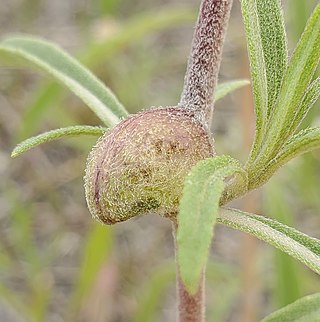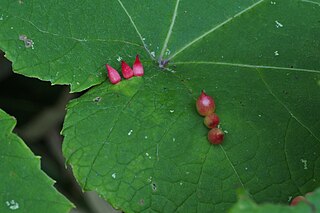
Cecidomyiidae is a family of flies known as gall midges or gall gnats. As the name implies, the larvae of most gall midges feed within plant tissue, creating abnormal plant growths called galls. Cecidomyiidae are very fragile small insects usually only 2–3 mm (0.079–0.118 in) in length; many are less than 1 mm (0.039 in) long. They are characterised by hairy wings, unusual in the order Diptera, and have long antennae. Some Cecidomyiids are also known for the strange phenomenon of paedogenesis in which the larval stage reproduces without maturing first. In some species, the daughter larvae consume the mother, while in others, reproduction occurs later on in the egg or pupa.

Asphondylia is a cosmopolitan genus of gall midges in the family Cecidomyiidae. All species in this genus induce galls on plants, especially on flowers and flower buds. There are over 300 described species in Asphondylia, with many more likely to be discovered and described, especially in the southern hemisphere.

Asphondyliini is a tribe of gall midges in the family Cecidomyiidae. There are about six genera and at least 100 described species in Asphondyliini.

Rhopalomyia is a genus of gall midges, insects in the family Cecidomyiidae. There are at least 267 described species in Rhopalomyia. Most species in this genus induce galls on plants in the Asteraceae. This genus has a cosmopolitan distribution. Rhopalomyia was first established by Ewald Heinrich Rübsaamen in 1892.
Harmandiola castaneae is a species of gall midge, insects in the family Cecidomyiidae. This species induces leaf galls on Castanea dentata. It was first described by Fannie Adelle Stebbins in 1910.
Asphondylia betheli is a species of gall midge in the family Cecidomyiidae. This midge is widespread in the southwestern United States. The larvae of this species induce galls on in the fruit of Opuntia cacti.

Asphondylia helianthiglobulus is a species of gall midge in the family Cecidomyiidae. The larvae of this species induce galls on the stems of several sunflower species in eastern North America, including Helianthus giganteus,H. grosseserratus, and H. maximiliani.
Catotricha americana is a species of basal gall midges in the family Cecidomyiidae. It is the type species of the genus and has only been confirmed to occur in New Hampshire. This species was first described by American entomologist Ephraim Porter Felt in 1908.
Catotricha is a genus of midges in the family Cecidomyiidae. The five described species in Catotricha are found in the holarctic region. This genus was established by British entomologist Frederick Wallace Edwards in 1938.

Ampelomyia vitiscoryloides, the grape filbert gall midge, is a species of gall midge in the family Cecidomyiidae. It induces galls on grape plants and is widespread in eastern North America. It was first described by Alpheus Spring Packard in 1869.

Asphondylia floccosa, the woolly stem gall midge, is a species of gall midges in the family Cecidomyiidae. The larvae induce galls on Atriplex polycarpa. This species is known from Arizona and California, and was first described by American entomologist Raymond Gagne in 1968.

Asphondylia solidaginis is a species of gall midge (Cecidomyiidae) that induces galls on goldenrods in North America where it is widespread. It was first described by William Beutenmuller in 1907.
Ampelomyia is a genus of gall midges in the tribe Asphondyliini. It consists of the following four species, all of which form galls on grape plants:
Anabremia is a genus of gall midge in the family Cecidomyiidae. The six described species are found in the Palearctic and likely inquilines of Dasineura galls on plants in the legume family. This genus was first described by Jean-Jacques Kieffer in 1912.
Massalongia is a genus of flies in the family Cecidomyiidae. The larvae induce galls on birches.
Asphondylia amaranthi is a species of gall midge in the family Cecidomyiidae.
Asphondylia antennariae is a species of gall midge in the family Cecidomyiidae. The larvae of this species induce galls on the buds of Antennaria plantaginifolia. This species is known from Wisconsin and Maine in the United States, though it's host plant is widespread in eastern North America. It was first described by American entomologist William Morton Wheeler in 1889.
Berestella is a genus of wood midges in the family Cecidomyiidae. The only described species - Berestella insuperabilis - is only known from Rovno amber from the Late Eocene. The genus was established in 2007 and named for Ukrainian entomologist Zoya L. Berest.
Cretomycophila is a genus of wood midges in the family Cecidomyiidae. The one described species - Cretomycophila ekaterinae - is only known from Taymyr amber from the Late Cretaceous.

Ampelomyia conicocoricis is a species of fly in the family Cecidomyiidae. It induces galls on grape plants in Japan. This is the type species for the genus.









